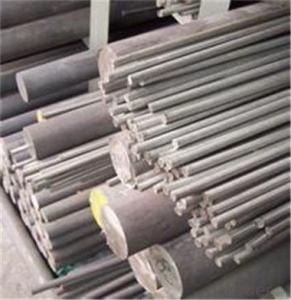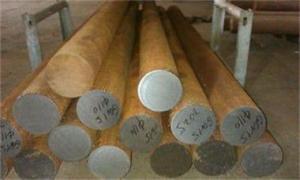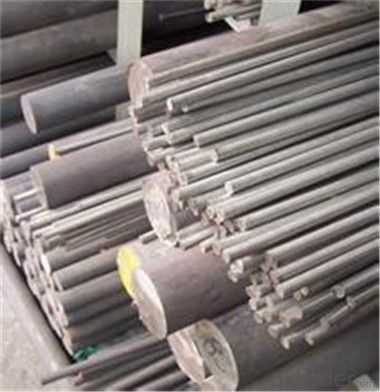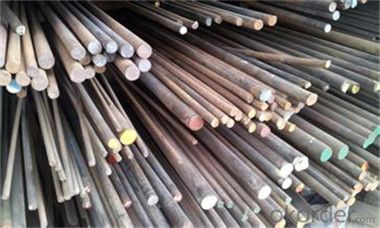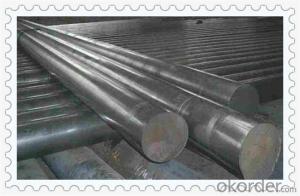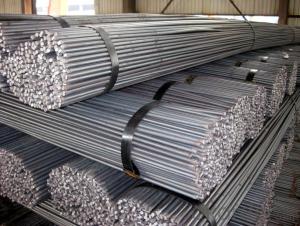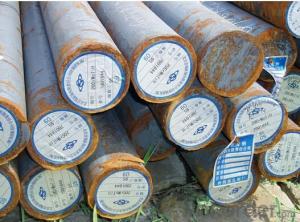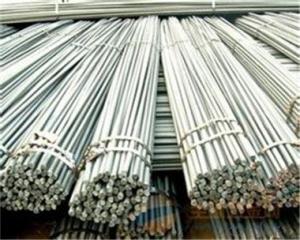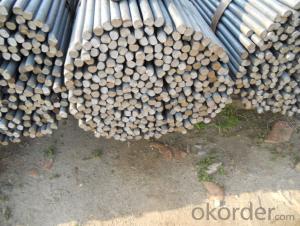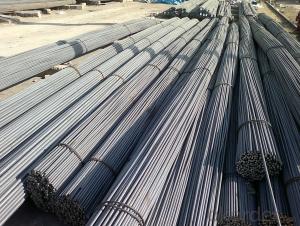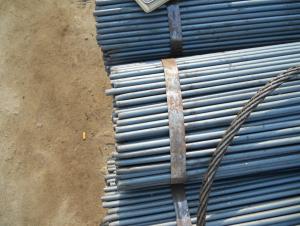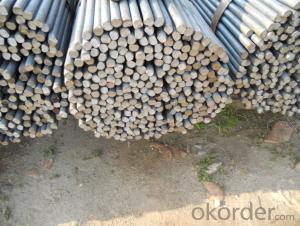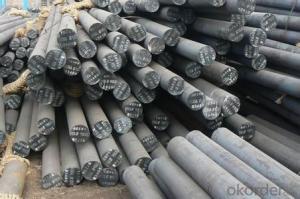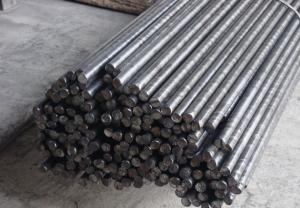Steel Round Bar 12L14 1214 1215 Free Cutting in China
- Loading Port:
- Tianjin
- Payment Terms:
- TT OR LC
- Min Order Qty:
- 90 m.t.
- Supply Capability:
- 2000000 m.t./month
OKorder Service Pledge
OKorder Financial Service
You Might Also Like
Description of steel round bar:
Is used mainly for force for small size and finish requirement strict instruments and meters, watch parts, automobile, machine tool and other kinds of machines used, strict with dimension precision and smooth finish, and the mechanical performance requirements are relatively low standard parts, such as gear, shaft, bolts, valves, bushing, pin, tube connectors, spring cushion, machine screw, plastic molding, procedures of surgical and dental appliances, etc.
Festures of steel round bar:
4340 Forged Round Steel Bar have good tenacity,hot tirdness nature and definite wearable;empty quenching under lower Austenitic temperature condition.small distortion after heat-treatment and so on.
Specifications of steel round bar:
Description |
Carbon Steel Rod/Carbon Steel Bar,carbon steel rod,carbon steel shaft,mild steel bar, mild steel shaft,ms bar | |
Material | ASTM | 1005,1006,1008,1010,1015,1020,1025,1030,1035,1040,1045,1050,1055,1060,1065,1070,1080,1084, 1016,1022 |
DIN | Ck10,Ck15,Ck22,Ck25,Ck30,Ck35,Ck40,Ck45,Ck50, 30Mn4,40Mn4 | |
BS | 040A04,095M15,045M10,080A40,045M10,080M50 | |
Standard | GB/T799,ASTM A29,A108,A321,A575,BS970,DIN1652,JIS G4051 | |
Section shape |
Round | |
Length |
As your required | |
Application | Carbon steel rod applies to chemical industry, shipping industry, | |
Images of steel round bar:
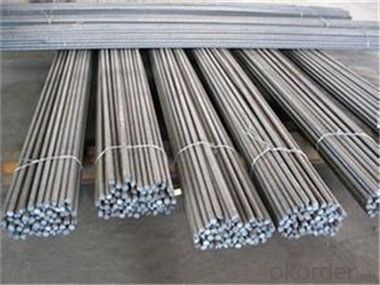
FAQ:
1. What is your package?
Packing situation: standard seaworthy packing or as customer required.
2. How long is the lead time?
Delivery time: 45 days after order confirmed.
- Q: What is the difference between a cold-drawn and a centerless ground steel round bar?
- Both cold-drawn and centerless ground steel round bars are distinct types of steel bars that have undergone different manufacturing processes, leading to varied characteristics and properties. To produce cold-drawn steel round bars, a hot-rolled or annealed steel bar is pulled through a die, decreasing its diameter and increasing its length. This procedure enhances the steel's mechanical properties, making it stronger, more precise in dimensions, and possessing a smoother surface finish. Cold-drawn bars exhibit superior tensile strength, improved surface finish, and tighter dimensional tolerances compared to hot-rolled bars. They are frequently employed in applications that necessitate precision and strength, such as automotive components, machinery parts, and construction materials. On the contrary, centerless ground steel round bars are created by passing a cylindrical steel bar through a grinding machine without the need for centers or support. This grinding process eliminates surface imperfections and deviations in diameter, resulting in a precise and smooth finish. Centerless ground bars offer exceptional dimensional accuracy, surface finish, and roundness. They are commonly utilized in applications where precision and tight tolerances are crucial, such as in the production of bearings, shafts, and hydraulic cylinders. In conclusion, the primary distinction between a cold-drawn steel round bar and a centerless ground steel round bar lies in the manufacturing process and the resultant properties. Cold-drawn bars are formed by pulling the steel through a die, leading to enhanced mechanical properties, tighter tolerances, and a smoother surface finish. Centerless ground bars are produced by grinding the steel to enhance dimensional accuracy, roundness, and surface finish. Both types of bars possess their own advantages and are suitable for different applications based on the required precision, strength, and surface finish.
- Q: How are steel round bars stored and transported?
- To ensure the safety and ease of handling for steel round bars, a variety of methods are employed for their storage and transportation. Typically, warehouses or outdoor yards serve as storage locations for these bars. Within these facilities, horizontal stacking on racks or placement on steel stands is a common practice to prevent any damage or deformation. It is essential to keep the bars elevated from the ground to avoid contact with moisture and potential rusting. For transportation purposes, steel round bars are often bundled together using steel straps or chains. These bundles are designed to tightly secure the bars and prevent any movement during transit. Furthermore, the bundles are frequently labeled with pertinent information such as steel type, dimensions, and weight to ensure proper identification and handling. The transportation of steel round bars can be facilitated by trucks, trains, or ships, depending on the distance to be covered. Shorter distances typically utilize trucks and trains, while ships are preferred for longer hauls, especially for international shipments. The loading process may involve flatbed trucks or shipping containers, depending on the size and weight of the bars. During transportation, it is crucial to avoid any potential impacts or mishandling that could cause damage to the bars. To achieve this, proper securing and bracing techniques are employed to minimize movement or shifting during transit. The use of blocking and bracing materials is common practice to prevent rolling or sliding of the bars. In conclusion, steel round bars are stored in warehouses or outdoor yards and bundled together using steel straps or chains. They are transported using trucks, trains, or ships, with careful attention given to securing and bracing to prevent damage. By adhering to these storage and transportation practices, steel round bars can be delivered safely and efficiently to their intended destinations.
- Q: How is the weight of a steel round bar calculated?
- The weight of a steel round bar is calculated using the formula: weight = volume × density. The volume of a round bar is determined by multiplying the cross-sectional area (πr^2) with the length of the bar. The density of steel is usually known, so by plugging in these values, we can calculate the weight of the steel round bar.
- Q: What is the maximum length of a steel round bar?
- The maximum length of a steel round bar can vary depending on several factors such as the diameter of the bar, the manufacturing capabilities of the steel supplier, and the transportation limitations. Generally, steel round bars are produced in standard lengths that range from 6 to 12 meters (20 to 40 feet). However, it is possible to manufacture longer bars through special processes or by joining multiple bars together using welding techniques. In some cases, steel round bars can be custom-made to exceed standard lengths, but this would require specific arrangements with the supplier and considerations for logistics and handling during transportation. Ultimately, the maximum length of a steel round bar is determined by practical limitations and the specific requirements of the project or application.
- Q: What are the advantages of using creep-resistant steel round bars?
- There are several advantages of using creep-resistant steel round bars in various applications. Firstly, creep-resistant steel round bars offer excellent resistance to high temperatures and prolonged exposure to stress. This makes them ideal for use in applications that involve high temperature environments, such as power plants, boilers, and engines. The ability to withstand elevated temperatures without losing their mechanical properties is a key advantage of creep-resistant steel round bars. Secondly, these round bars have superior creep strength, which means they can withstand constant stress over a long period of time without deforming or failing. This is particularly important in applications where the component is subjected to continuous stress, such as in pressure vessels or structural components of machinery. The high creep strength of these bars ensures the longevity and reliability of the components. Additionally, creep-resistant steel round bars have excellent corrosion resistance. They are often alloyed with elements such as chromium, molybdenum, or nickel, which enhance their resistance to corrosion in harsh environments. This makes them suitable for use in industries such as oil and gas, chemical processing, and marine applications where corrosion is a significant concern. Furthermore, creep-resistant steel round bars have good weldability, allowing for easy fabrication and assembly. They can be easily welded to other components without compromising their mechanical properties, making them versatile and cost-effective for various construction projects. Moreover, these round bars offer dimensional stability and high hardness, ensuring that the components maintain their shape and mechanical properties even under extreme conditions. This characteristic makes them suitable for use in applications that require high precision and accuracy, such as aerospace and automotive industries. In conclusion, the advantages of using creep-resistant steel round bars include their ability to withstand high temperatures, excellent creep strength, corrosion resistance, weldability, dimensional stability, and high hardness. These advantages make them a preferred choice for various industries where reliability, longevity, and performance under harsh conditions are crucial factors.
- Q: Can steel round bars be used in the manufacturing of household appliances?
- Yes, steel round bars can be used in the manufacturing of household appliances. Steel is a versatile and durable material that is commonly used in various industries, including the manufacturing of household appliances. Steel round bars can be utilized in the construction of appliance frames, support structures, and even internal components. The high strength and resistance to corrosion of steel make it an ideal choice for ensuring the durability and longevity of household appliances. Additionally, steel can be easily molded and shaped according to specific requirements, allowing for the production of appliances with intricate designs and precise dimensions. Overall, the use of steel round bars in the manufacturing of household appliances contributes to the production of high-quality, reliable, and long-lasting products.
- Q: How do you calculate the moment of inertia for a steel round bar?
- The moment of inertia for a steel round bar can be calculated using the formula for the moment of inertia of a solid cylinder, which is given by I = (1/4)πr^4, where I is the moment of inertia and r is the radius of the round bar.
- Q: Are steel round bars available in different shapes?
- No, steel round bars are specifically designed and manufactured to have a cylindrical shape and are not available in different shapes.
- Q: What are the common defects found in steel round bars?
- Steel round bars may possess several common defects, including surface cracks, internal voids, inclusions, segregation, and dimensional variations. Surface cracks can arise from manufacturing processes or improper handling and transportation, resulting in compromised structural integrity and reduced load-bearing capacity. Internal voids, also known as blowholes or cavities, emerge as empty spaces within the steel caused by trapped gases during solidification. These voids can detrimentally affect the mechanical properties of the bar, rendering it more susceptible to failure under stress. Inclusions, non-metallic particles or impurities, may be present in the steel. They may originate from raw materials used in production or contaminants introduced during manufacturing. Inclusions diminish the strength and ductility of the steel and can serve as starting points for cracks. Segregation refers to the uneven distribution of elements within the steel. It can occur during solidification, leading to areas of the bar with distinct chemical compositions. Consequently, variations in mechanical properties, such as hardness and toughness, arise, resulting in inconsistent performance. Defects can also manifest as dimensional variations, such as out-of-roundness or fluctuations in diameter. These variations impact the bar's fit and functionality, especially in applications requiring precise dimensions. To ensure the quality and reliability of steel round bars, particularly in applications demanding high strength and performance, it is crucial to identify and rectify these defects. Regular inspections, implementation of quality control measures, and adherence to industry standards and specifications aid in minimizing these defects and upholding the integrity of steel round bars.
- Q: What are the different types of steel round bar surface finishes for improved lubricity?
- To enhance lubricity, there exists a variety of surface finishes for steel round bars. 1. Achieving a smooth finish involves employing grinding or polishing techniques to create a sleek surface. This reduces friction and serves as a solid foundation for applying lubricants. 2. Chrome plating entails electroplating a layer of chromium onto the round bar's surface. This results in a hard, smooth, and corrosion-resistant coat that offers exceptional lubricity. Chrome plating is frequently employed in applications necessitating low friction and wear resistance. 3. Nitriding, a surface hardening process, involves diffusing nitrogen into the round bar's surface. This generates a robust layer that amplifies the steel's lubricity. Nitriding is commonly utilized when high wear resistance and improved lubrication are imperative. 4. Black oxide, a chemical conversion coating, forms a black surface on the steel round bar. This finish provides a thin layer of protection against corrosion along with enhanced lubricity. Black oxide is frequently favored in applications that require lubricity without a decorative appearance. 5. Teflon coating, also known as PTFE (polytetrafluoroethylene) coating, involves applying a thin layer of Teflon onto the round bar's surface. This coating offers exceptional lubricity and low friction properties. Teflon coating is often employed in industries like food processing or packaging that necessitate non-stick properties. These examples showcase the various steel round bar surface finishes that can be utilized to enhance lubricity. The choice of finish depends on specific application requirements and the desired level of lubrication and wear resistance.
Send your message to us
Steel Round Bar 12L14 1214 1215 Free Cutting in China
- Loading Port:
- Tianjin
- Payment Terms:
- TT OR LC
- Min Order Qty:
- 90 m.t.
- Supply Capability:
- 2000000 m.t./month
OKorder Service Pledge
OKorder Financial Service
Similar products
Hot products
Hot Searches
Related keywords
